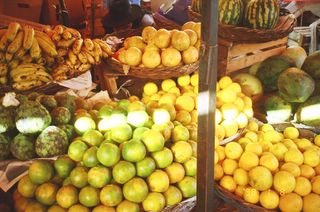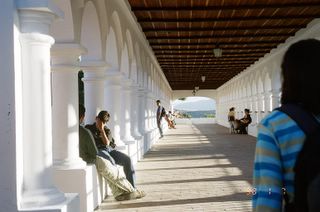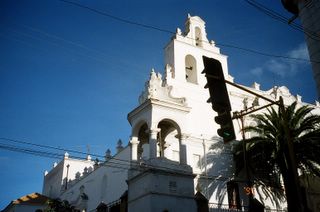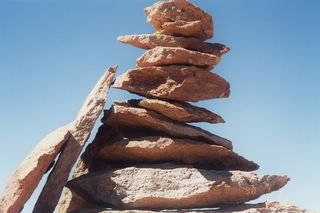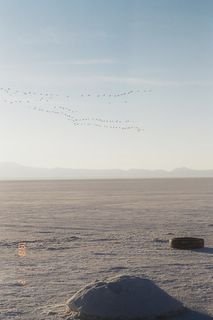Friday, June 02, 2006
Tuesday, May 02, 2006
While hiking across the Isla Del Sol last week with a couple other kids, we stopped into the "Museum of Aymara Culture" tucked into a little village halfway down the island. The museum itself wasn't much, but the curator, a short, intense Aymara indian, was almost too much. By the time we left, we were all looking at each other like "That's strange.. I came for a museum and got a spirtual re-education replete with end-of-the-world predictions." Here are some translations of the science he dropped on us (at least that which I could understand and absorb).
"What I am going to tell you is what I believe, what was taught to me by father. My father was a great master of astrology. My mother was a master of herbal medicines and spells. What I will tell you is not what the acheologists, anthropologists and scientists will tell you. They will tell you this island is filled with Inca ruins. This is not true. All the ruins here are from civilizations much older than the Incas. They are from my people. They say they are Inca. I do not like the Inca."
"The name of this island is 'TI TI CR RCK CKA!'. Not 'titicaca'. Here is where the name comes from. My father taught me that a long long time ago, there were two moons that circled the Earth. Then, one of the moons crashed into the Earth, right here, and created Titicaca. The name has two parts- 'Titi', which I will explain later, and 'CRRRK CKA!' which is the sound when the moon smashed into the earth. When this happened, the great city of my people went under the water. There are cities just like Atlantis in the lake here. The archeologists have found them. Now they are covered with water. This lake was once a part of the Pacific ocean."
At this point the German guy we were with made a very German inquiry.
"But the water here is sweet (they say 'sweet' instead of fresh in Spanish) and the water is the ocean is salty"
"Yes, this is something the scientists will tell you. But my father told me that there are many chemicals and minerals in the soil here which, over many years, changed the makeup of the water from salty to sweet."

He showed us the many colored Quechuan/Aymara flag and explained the significance of each of it's colors and their placement. He instructed us to hold hands in a circle around it. But when I offered him the traditional western handshake, he rebuked me.
"No! This," he gave me the American handshake, "is a handshake of hate. Of domination. This," he arranged our hands into something like the second part of the "Bro" or 70's Black Power handshake series, "this is how to hold hands."
He showed us how a figure resembling hands clasped in this matter was a motif found on much of Aymara pottery and handicrafts in the museum. It also sort of resembled a blocky version of the Yin Yang.
He brought us to a number posters depicting famous "Inca" ruins on the island. He told us the names that they are referred to by archeologists, guide books and tourists alike, then told us their "true" Aymara names, which were all as onomatopoeic and spittle-triggering as "TitiCRRK-KA!". He told us which were used for sacrifice and which were "centers for great masters" of things like "Plumeria"- making art and spiritual artifacts out of feathers, particularly hummingbird feathers, which come in all the colors of the Aymara flag.
After awhile he said "I'm cold, let's go outside." We sat in the grass and he began to draw things for us in a notebook. He showed us an Aymara totem symbol made with lots of reprentations of animals. "This," he showed us a little squiggle that looked like a cat. "Is a puma. But it is not a puma. All the scientists and anthropologist come here and say 'It is a puma.', but it is not. It is a 'Titi'. A Titi is more like a cat, a regular cat, small. It is a very powerful animal for my people. Now, it lives under the water, in the underwater cities. It only comes out during a full moon."
At this point I wanted to ask if this animal was a "Real" animal or a "Just some shit we made up" animal, but i figured the question by it's very nature was offensive. I didn't want to be cast in the same category of scorn as the "scientists, archeologists and anthropologists", so I kept my mouth shut.
"And this," He pointed to another squiggle, "It a serpiente. This is very powerful, too. Because the serpent is very smart, quick. We all have serpent power, our backbone and our head."

He started to draw other figures for us. He drew the "cruce de los andes", (right) and showed us how each side represented a month of the year, and somehow he related this to the Mayan calandar, we he then started to explain.
He drew a chart showing two periods of time: our time, in which there is one sun. "This is the Sun- Inti. And it is a sun of sadness, hate, craziness." Then he showed us how we were poised at the end of this period, which according to his scale had been going on for a very long time. He showed us how around 2012 we would enter into a brief period of darkness, war and famine in which much of the world's population would die. "But," he assured the German guy, who must have appeared alarmed, "Many people with wisdom will survive. You will survive, because you have serpent power."
"Then, after this we enter the Inti-inti- a period of paz, luz y amor . We will have two suns, and it will be a sun of paz, luz y amor." He drew us a representation of the Earth. "My father taught me that there are two centers of energy in the world. Here," he showed us Titikaka, "and here. Tibet. When we are in the dark period, this is where the world will turn to. And in the end, we will all be the same, no race, no class."
We wondered later if this meant that we would all become Aymara, and if so would we all begin to defy the no-double-starch-on-one-plate rule that the Bolivians so cheerfully violate.
We all held hands once again and he blessed us and assured us that we would all make it through the dark times. Then he asked for 10 bolivianos. Which we were more than happy to pay.
Sunday, April 30, 2006
NOTAS DE BOLIVIA: la paz, la paz
I am leaving an internet cafe somewhere in La Paz at some time approaching the middle of the night. I am leaving because 6-year-olds often wander into internet cafes in La Paz in the middle of the night and start playing computer games with loud shooting and explosion sounds right next to you and if you tell them to turn it down they will give you a look like they had no idea that one could turn the volume on a video game down and everyone else, including the owner, will look at you like a gringo who thinks he runs the place.
"2 bolivianos." The owner says as I am standing by the front door. A car blurs past and there is an enormous crushing "Bang!" like the car had plowed into a hot dog cart. I am on the front step and look towards where the noise had come, see the kid lying prone in the street. The car is gone. The owner is there next to me, he sees the kid, too. I go to approach the body and the owner stops me. "2 bolivianos.", he says.
After I've paid and he's rooted around for my change, we both go outside. The kid is about 14, lying on his back with his eyes partly open. There's no obvious damage to his body, but he hasn't moved. His eyes are pointing toward the sky sightlessly.
There are a few people coming up to investigate like us. A lady keeps leaning over him and saying "Joven! Joven!". People are arguing about what color the car was. Someone is calling for help on a cellphone.
The lady returns with some water and splashes it on the kid´s face. "Joven! Joven!"
A crown is forming. The people who are pushing up behind me to get a look smell like booze. Some people seem positively excited.
"Joven!" Once I see his pupils move, tracking someone's movement, but it looks like the eye movement of a deer or a cow, like the animal part of his brain is in charge.
In a moment a cop car pulls up. Young cops jump out and try his jugular pulse roughly, like an attack. The cops, quite against the guidelines for possible spinal injuries, grab him by the arms and legs and toss him in the back of their car.
There's a stain on the pavement where the lady dripped the water. A girl bends down and touches it, looks at her finger. "No es sangre," she chastises her boyfriend, "Es agua!" She says, disappointed.
Friday, April 28, 2006
NOTAS DE BOLIVIA: top models
I am sitting at the back bar at Mongo's, a gringo bar in La Paz where locals also go, with Matthias, a German/Kiwi friend. In walk three young, pretty Bolivian girls and an older Bolivian man. They sit next to us at the bar. After they order, the guy starts to talk to us in english. It seems he went to school in Madison, Wisconsin for engineering.
"Are you an engineer down here?" I ask.
"No, I work in the movies. I also worked in New York for HBO, I had my own production company."
"Well, why did you decide to move back down here?"
"My father died. I didn't really have a choice. But I have my own company here, now." He hands me his card. "These girls are in the movie I am working on." They smile. They all have ponytails and two have hoop earrings. One has a t-shirt that says "I (HEART) ME" in sparkles. He says something to the girls and turns back to me. "I'll be back in a minute. Here, talk to her. She's trying to work on her english."
I ask them their names. They are drinking things like Bailey's or Kaluha and smoking cigarettes. I ask them how old they are. Two say "Dieciséis.", and one says "Dieciocho".
"Que tipo de pelicula ustedes son las estrellas de?" I ask.
"Romantico." They all say.
I look at the card I had been given. It is all pink and says "Top Models".
NOTAS DE BOLIVIA: hoops skirt and bowler hat
A bolivian lady on the bus next to you, what does she smell like? Body odor, farm animals (llamas), food (meat and onions), coca leaves, herbs, urine, a greenhouse. Every time. And it is never quite unpleasant.
NOTAS DE BOLIVIA: how to live like a Bolivian
How to Live like a Bolivian: Eat a large fried empanada filled with meat, chicken, egg, onions, potatos and peppers while standing at an empanada cart on a street corner in La Paz. Spoon salsa picante, salsa de mani, golf sauce, and mayonaise on it after every bite. As soon as you finish the last bite, throw a 50 centavo piece at the the empanada lady and say "Gracias". Turn and walk directly up a 75 degree incline for 4 city blocks.
I tried it. My heart didn't understand what was going on. It seemed shocked and appalled. Little old ladies were brushing past me carrying a babies and small children. I had to stop at some point (not at the the top of the hill- the hills in La Paz don't end. It's like a Mobius strip, if you keep walking up eventually you find yourself at the bottom) until the dizzyness and heartburn passed.
I guess the only thing more Bolivian and cardiac-arrest inducing to do would be a gram of Bolivian coke in between, but I didn't go there.
NOTAS BE BOLIVIA- good friday, La Paz
-Good Friday: I am walking down the center of the largest boulevard in La Paz. The rain just stopped and the sun is intense. Passing cars are sprinkling muddy water from the brimming gutters. Suddenly there is a bolivian guy next to me, in his mid twenties. He is wearing wraparound sunglasses and a Sf 49ers hat. There is white crust in the corners of his mouth. "Give me some money." he says in english, "Give me money, for something to drink."
"No." I say
"You don't have some money?"
"No." I lie, obviously.
"Fuck you you mother fucker. Bitch tight mother fucker wont give me no fucking money fuck you!" He keeps ranting as stalks off and starts to cross the road.
"Hey," I call after him, "How much did you pay for that hat? How much for the glasses?" He is also wearing a new vinyl coat and new jeans.
"Fuck you..." he keeps babbling and stalking manically up the other side of the street.
But we are heading in the same direction, so at a corner two blocks later he walks right by me again, brandishing a bright length of cloth which startles me at first. He curses at me again as he passes, so I say "Hey do you want to talk? I am willing to talk with you."
I mean it, but it comes out sounding like a threat, more like "I am willing to fuck with you."
I want to tell him that they are tons of little kids and old women all over the streets who want money from me, too. There are people with physical deformities and mental handicaps, dirty and desheviled. I hardly ever even give money to these people. Why would I ever give money to obvious junkie like him? A full-grown able-bodied young man who wants money for a "drink". If it's bottle he's after it's probably a bottle of glue.
He just turns back and says "I'll see you in the Jungle tonight."
Two hours later, at an outdoor market halfway across the city and high above where I first saw him, unbelievably, I see him again. He is walking by and makes a kissing noise at me. This time he is sans hat and glasses.
"Como Onda, Amigo?" I say.
He just holds up a 5 bolivian coin as he walks by.
"Que suerte por usted." I say.
-Good Friday: graphitti: Jesus = Hippie
-Good Friday: Found two flyers for satanic death metal shows next week in La Paz.
-Good friday: procession. Pushing through the throngs of people jamming the sidewalks of the narrow streets to catch up with the virgin. She is flanked by regimens of Bolivian soldiers in German WWI uniforms- swords and polished spiked helmets; riding on an ornate coffin hefted by pallbearers in black Klu Klu Klan robes and hoods. Ahead, the military brass band plays a funereal dirge somewhere between the John Williams "Death Star theme" and "The Fool" by Neutral Milk Hotel. Ahead of that, I know, is Jesus himself, bearing his cross and surrounded by midevil executioners straight from Hagar the Horrible. A woman aside me keeps telling me how to say "Como estas" in Quechuan and I keep forgetting. I am trying to get ahead of the virgin to see her face. All I can see from behind is her black velvet cloak a feint halo from her christmas-light crown.
From the tone of everything else, I think she must be terrible- a horrible shriveled mummy of a real woman, or a mass of snakes with eyes that bleed. Maybe this is a Haitian voodoo parade. But I cant get ahead of her, it's like a dream. Children and old men keep walking very slowly in front of me, and I can't jostle them, they are here out of more than morbid curiosity. Or are they? Slight altitude sickness and slight fever brought on by the plummeting temperature and the horrid bus ride the night before are giving it all a surreal sheen. Hessians with sabers? Faceless black pallbearers?
A girl told me she saw the president, Evo Morales, in the procession today. She said he was wearing a red leather jacket and looked like a Columbian cowboy. Evo is Bolivia's first indiginous president. The tormented Jesus up ahead of me, though, is sure to be just the latest in a long line of Quechuan Jesuses. Eventually I see the virgin- snow white porcelin doll, 3 feet tall. The whole thing to me is an elaborate irony- a deliborate inversion of the myth. In this version, the faceless hordes of the military are there to PROTECT Jesus and the holiness of the virgin Mary. Mary, of course is inanimate, blind, a symbol or empty vessel of a woman borne on by real women with their faces covered and transformed into parodies of grief or evil. Here, the government is a freind to Jesus, not his enemy and murderer. The only villians are the thuggish executioners (the jews?) who ensure that Jesus will keep dragging his cross around, wearing make-up, every year forever. Pontius Pilate is a Christian Quechuan Cowboy waving to the crowd. The band bleats on in mournful resignation of the whole affair.
-Good Friday: graphitti- "El Che y el evo son la mismo: Padres Iresponibles" (The Che and the Evo are the same- irresponible fathers." credited to- "Mujeres creandos" (creative women) with an anarchy symbol that extends down into the female symbol.
"Dos Locos Sin Auto!"
Wading through the bootleg DVD stalls in La Paz, looking for gifts for my little sister (which was largely unproductive, Cait, sorry, I'll find you something in Buenos aires), I was dumbfounded by some of the titular translations of the movies on offer, which are 90 percent of Hollywood origin. So often it seems that even though a straight-up literal translation into Spanish would be perfectly adequate, the translators get fancy and stumble horribly.
Example: Rushmore. A perfectly fine title, somewhat iconic and unfuck-withable, and a proper noun to boot: non-language-specific and therefore no need to translate. In South America it becomes: Tres es Multitud (Three's a Crowd). It goes from a kind of obtuse, monolithic one word coda to a 70´s sit-com.
But they could have done worse. There seems to be a great demand for comedies in South America that advertise themselves as involving Locos (crazy guys). I beleive that the translators belive that if a film involves Locos or any action that could be considered loco, there should be fair warning, in case any viewers are sensitive to these things.
Therefore, Wonder Boys becomes Fin de Semana de los Locos (Weekend of the Crazy Guys).
Planes, Trains and Automobiles is perfectly translatable, yet they went with Dos Locos en Vacaciones, which maybe is accurate, yet just not the same.
I´ve also seen the Cuba Gooding Jr. nautical sex-farce classic Boat Trip titled as something like Cruise de los Locos, which misses a lot of subtleties of that complex work.
Another modern classic, Christmas with the Cranks gets dumbed down to Navidad con Los Locos. I don't know how anyone could watch Tim Allen's performance in that and confuse his crankiness with craziness!
Finally we have my personal favorites- Burt Reynolds and Dom Delouise in Los Locos De Cannonball part 1 and 2 and, of course, Ashton Kutcher and Sean William Scott's breakout performances in DOS LOCOS SIN AUTO! (TWO CRAZY GUYS WITHOUT A CAR!).
Tuesday, April 25, 2006
The photos below are from a 4 day 3 night trip I did from Tupiza in the south of Bolivia to the Salar de Uyuni, massive salt flats a few hundred Km to the north. The trip took us through tiny villages, epic vistas, lagoons, up snowy mountains, through arid desert basins, through mountain streams, and green pastures all at an altitude hovering around the 5000 meter mark. That is 16,400 feet. At that altitude you feel like your head is going to explode. All there is to do is chew coca leaves and gape at the beauty around you. It was difficult to sleep at that height, you kept waking up with a throbbing headache and falling back into strange dreams. Some of the folks from the trip were really ill and uncomfortable for much of the really high parts. I felt like my skull had to expand to let more oxygen in. I figured that why most Bolivians are rather large-headed (literally, not idiomically.. thats Argentinians).
We saw tons of Flamencos, Vacunas, llamas, sheep, and lizards. I was on the hunt for the Gato Andino, a rare alpine feline that looks like a large housecat with a super long tail. Sadly I did not find one.
There was a lot of weird desert plants and cacti. One green mossy plant we kept seeing turned out to grow at a rate of 1mm a year. Some of these things were a meter wide. They were at least a thousand years old.
We ate tons of good food and Nelson, our guide, spoke slowly and clearly in Spanish so that we could understand everything. If you are coming down here I would definetely reccomend his company Tupiza tours. The 4 day trip will run you around 110 US.
Thanks Nelson, Etu, Matteus, Melissa (you saved me with that Dirty 3 CD out there!), Ren, Darit, and Hesham. Entonces...



